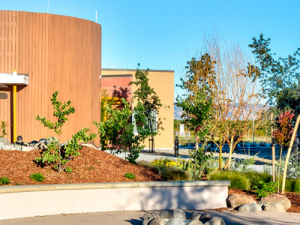Climate stressors and impacts
Hospitals located on or near the East or Southeast coasts of the United States are already vulnerable to the impacts of tropical storms and hurricanes, and climate scientists project that the intensity and rainfall rates associated with these storms will increase as the climate continues to warm. Storm surges from tropical storms and hurricanes can cause significant flooding, and wind damage poses another significant risk. To the extent that hospitals can anticipate these dangers and adapt ahead of time, they will be better able to serve their communities during weather-related disasters when access to urgent care is all the more important.
Recognizing the need for action
Nicklaus Children's Hospital (formerly known as Miami Children's Hospital) serves seven counties in southern Florida—it is the region’s only specialty hospital for children. Around 2000, the hospital conducted an assessment of its resilience to potential storm damage. Results of the assessment revealed that the facility’s exterior construction was unsafe in wind speeds associated with hurricanes of Category 2 and higher. Such storms are relatively common in southern Florida, so the assessment served as a call to action. Many of the special pediatric services provided at Nicklaus are not available in other hospitals in the region, so wind damage requiring the facility to be evacuated or closed would be particularly disastrous for children who need this specialized medical care. Thus, in 2001, the 268-bed hospital began a state-of-the-art retrofit to enable it to withstand a Category 4 hurricane.
Overcoming barriers
Hospital administrators faced two major challenges as they began the retrofit: how to fund the renovation project and how to renovate without disrupting medical services. The funding issue was resolved when the hospital received a grant through FEMA’s Hazard Mitigation Grant Program (HMGP), administered by the Florida Department of Community Affairs. The $5 million HMGP grant was a vital element enabling the $11.3 million project. Meanwhile, the architect’s plan to undertake all construction activity from the outside towards the inside of the building meant that surgeries, diagnoses, and nursing care for the hospital’s young patients could continue uninterrupted through all phases of the renovation.
The hospital is now wrapped in a hurricane resistant shell—the retrofit strengthened the building by encapsulating the three-story structure in pre-molded panels of glass fiber-reinforced concrete. This panel system, anchored into the building’s existing support structure, forms a protective cocoon around the hospital. Along with impact-resistant windows and a strengthened roof, the panel system is designed to withstand winds of up to 200 miles per hour.
The benefits of preparation
Construction concluded in the spring of 2004, just before the start of Florida’s hurricane season. When Hurricanes Frances and Jeanne struck that year, young patients and their families did not need to evacuate from the hospital. In fact, during those storms, Nicklaus hosted more than 60 children who normally lived at home but were evacuated from the Florida Keys. The hurricane-resistant hospital served as a haven for children who depended on ventilators or other electrically-powered medical equipment through these times of danger.
During Hurricane Frances, Nicklaus also served as a temporary refuge for nearly 1,000 staff members and their families. According to Kevin Hammeran, Senior Vice President and Chief Operating Officer, during this period, “The strengthened building has enhanced the hospital administration’s ability to recruit staff to serve during hurricanes. Many employees feel safer at the hospital during a storm than in their own homes. We also have eliminated barriers by providing on-campus shelter for family members of storm-duty staff. Knowing their spouses and children are within the safe confines of the hospital gives peace of mind to those working through the storm.”
Again in 2005, the hospital hosted medical evacuees and families who were displaced by Hurricanes Katrina and Wilma. The investment in increasing the facility's ability to withstand wind damage is proving to be a major contribution to the region's resilience.


